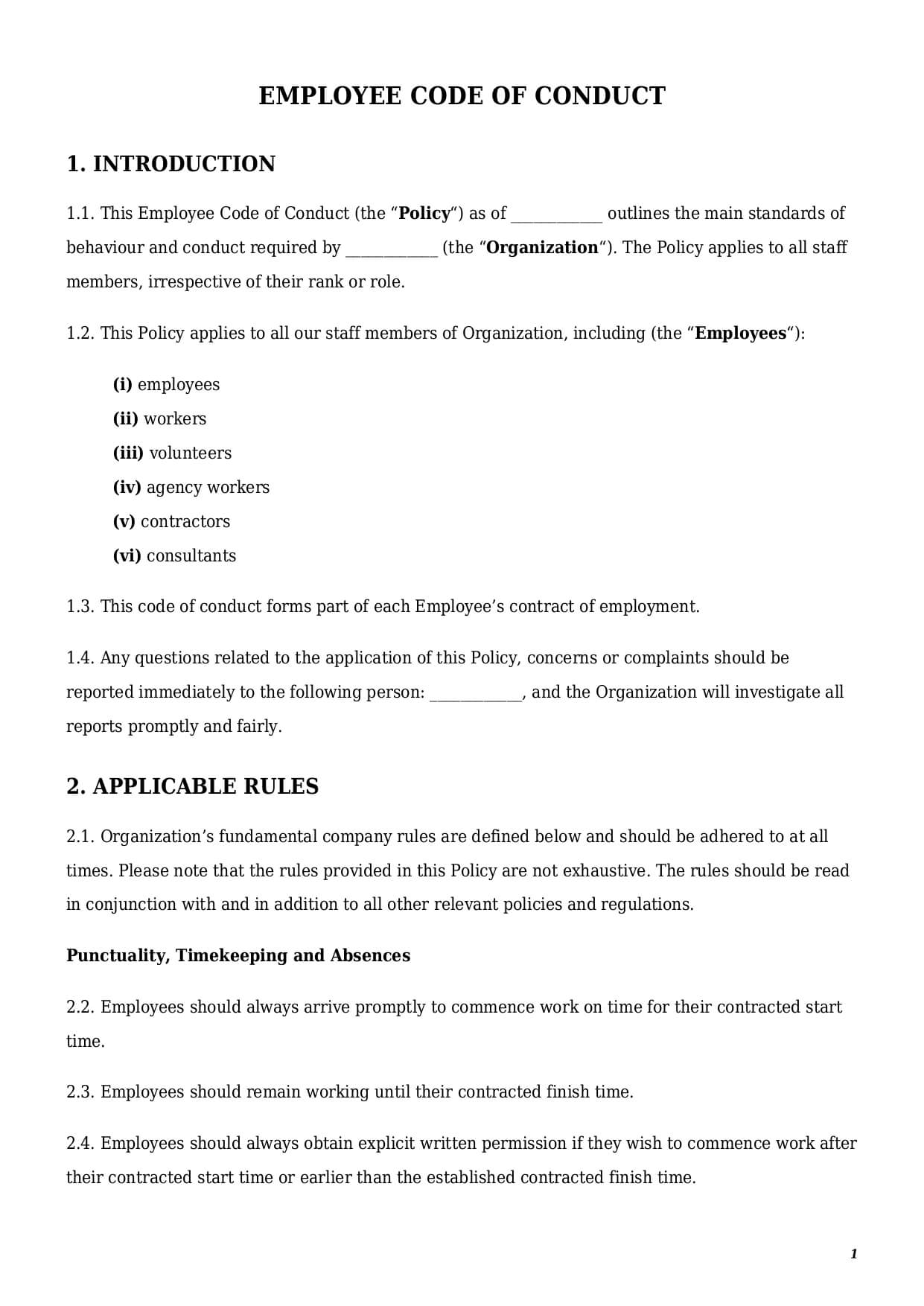Employee Code of Conduct
Reviews


What is an employee code of conduct?
An employee code of conduct is a formal document that sets out the standards of behavior, professional ethics, and workplace rules expected of employees within an organization. This document sets up a strong legal framework for staff while at the workplace or on duty. An employee code of conduct template usually covers:
- purpose and mission of the policy;
- categories of employees to whom this policy applies;
- behavior rules at the workplace;
- requirements for employees’ appearance;
- confidentiality obligations;
- policy amendment;
- consequences for non-compliance with policy.
Neither federal nor state law requires organizations to have an employee code of conduct sample. This is an optional, though very important, document in an organization’s corporate life.
An employee code of conduct is frequently used in conjunction with other corporate documents, including a gift policy or social media policy. Different policies normally focus on various aspects of internal corporate life and situations. However, it is very common to confuse the present template with an employee handbook. Below, we made a short checklist of differences between those two documents:
- Employee Handbook: An organization’s constitution and a summary of all policies, the organization’s culture, values, and missions. This document serves as an introduction for the new employees to get a sense of what the company or organization is like from the inside.
- Employee Code of Conduct Policy: This is a very specific document that narrows employees’ behavioral standards, working ethics, and disciplinary consequences.
How to draft an employee code of conduct template?
Drafting a strong employee code of conduct template is a must to ensure clarity and consistency of employees’ conduct across the organization. There are a number of clauses a solid policy for employees’ conduct shall include:
Scope of Application
A good example of an employee code of conduct policy shall define the list or categories of employees to whom such a policy shall apply. As a general rule, all full-time and part-time employees are normally covered by application of the policy. Those are individuals who are related to the organization by virtue of existing employment contracts. However, an organization may wish to include a broader scope of application, for instance:
- contractors, external advisors;
- interns or volunteers;
- remote employees and normal employees, etc.
Last but not least, in most cases employees are required to obey the employee code of conduct while at work or on duty. However, in a number of cases, following the code of conduct is an obligatory event outside of the workplace. For instance, if an employee is travelling for work, the rule of the employee code of conduct policy remains applicable.
Or, in a situation when an employee makes a social media post representing him as an employee of an organization. In those and other similar questions, an employee is required to follow behavior standards provided in the organization’s corporate policy.
Behavior in the Workplace
It is practically impossible to provide employees and workers with an exact list of things they should do or should not do while at work. At the same time, a solid employee code of conduct policy may suggest the list of most essential rules that constitute an organization’s core value or its philosophy. Those rules include the following:
- No discrimination: The organization may prohibit any form of discrimination, harassment, or bullying, including sex, race, gender, religion, etc.
- No bribery or prohibited gifts: Employees may not be allowed to accept any gifts or hospitality from third parties while on duty or that are related to their work at the organization.
- No lateness: Timekeeping is essential for every organization. Therefore, employees are normally required to track their arrival and departure, comply with working schedules, break limits, etc.
- No misuse of professional position: Employees must always carry out their working duties with professionalism and diligence, honesty, and integrity.
- No relationships at work: Most organizations prohibit employees having romantic relations with each other.
- No safety violations: If an employee’s position requires it, they have to wear at all times the required clothing or safety equipment to ensure their safety and the safety of others.
The list of examples may include other rules as well, depending on the type of organization and activities it is involved in.
Employee Appearance
Most employee code of conduct templates focus their attention on how employees shall dress while at work. Rules for dress code may apply towards all employees or only to several categories (e.g., employees who have direct access to the organization’s customers or clients).
The appearance of an employee is a complex notion that may include the limitations below:
- Formal dress code;
- Requirement for special uniform or equipment;
- Coverage of visible tattoos;
- Limitations or prohibition of wearing jewelry;
- Limitation or prohibition of wearing makeup.
Disciplinary Measures
For an effective application of a code of conduct, it is essential to include disciplinary measures. Disciplinary measures are legal consequences an employee who violates the code of conduct may face. Depending on the type of organization, in case of a policy violation, an employee may face:
- A written warning (if an employee receives two or more warnings during a certain period of time, it may lead to a contract’s termination).
- Immediate termination of employment relations.
- Refusal of employee’s promotion.
Policy Amendment and Publication
An organization has an undisputable right to change, modify, or amend in any way the employee code of conduct. Once amendments are introduced, the latest date of those amendments shall be reflected in the recent version of the policy.
For a policy to become a legally binding document, it should be communicated to employees. There are a number of ways how an organization may inform employees about the existence of the policy:
- by sending a personal email containing a link to the policy or an attachment;
- by printing out the policy and distributing copies among employees;
- by placing the policy on the organization’s official website, etc.
How to customize a policy template at Faster Draft?
To get a fully customized document template, follow a few easy steps below:
- Click the button “Create Document.”
- Answer simple questions in an employee code of conduct form.
- Select a document’s format—employee code of conduct PDF or Word.
- Make a payment.
- Download, print, and distribute the policy within an organization.
Table of content

Looking for something Different?
Start typing to find out our collection of legal documents and contract templates
